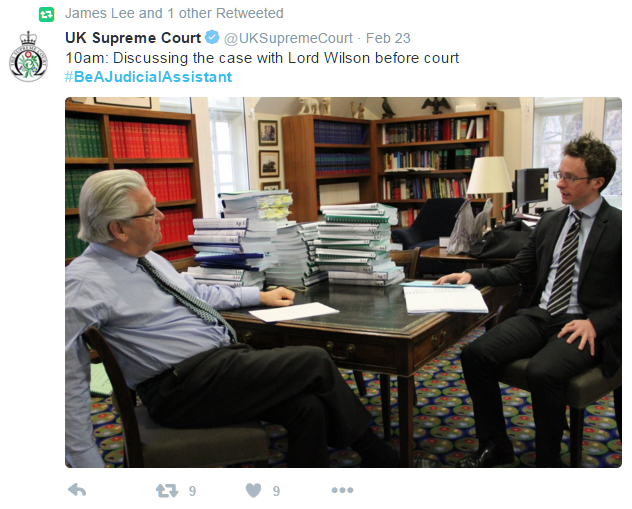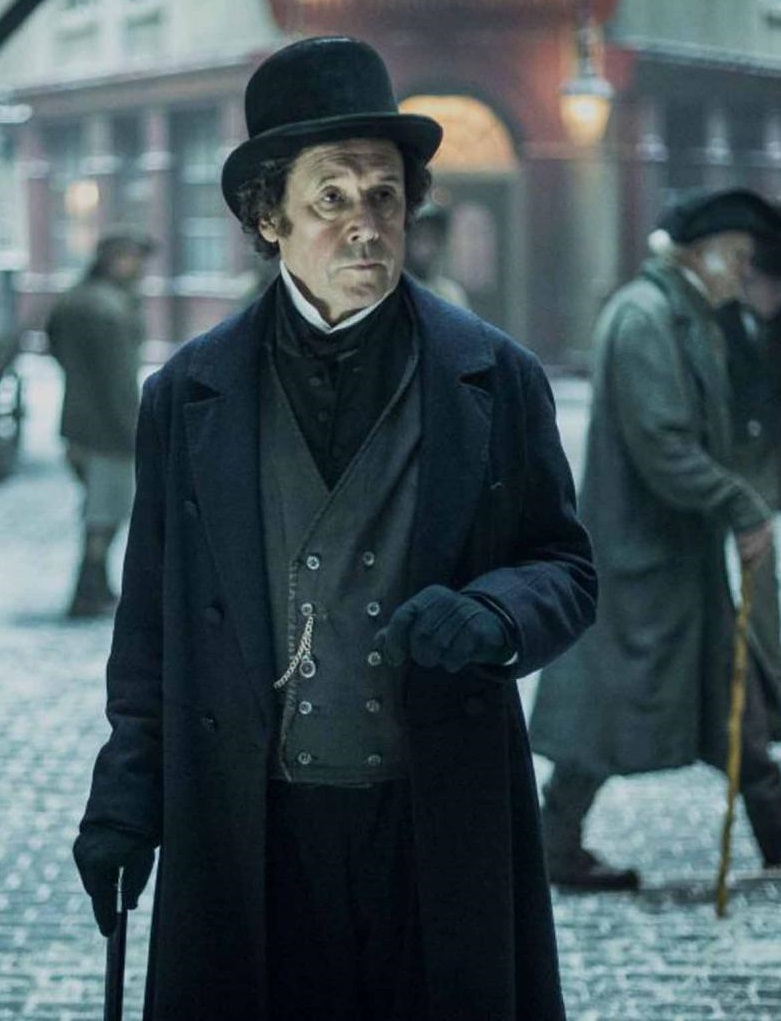Weekly Notes: legal news from ICLR – 26 February 2016
This week’s guided tour takes us behind the scenes at the BBC in the 1970s, to the more contemporary legal world of tribunals, prosecutors and the Supreme Court, and then back to the BBC for a mashed up glimpse of fictitious Victorian grime and detection. (But, no doubt to everyone’s relief, nothing this week about
This week’s guided tour takes us behind the scenes at the BBC in the 1970s, to the more contemporary legal world of tribunals, prosecutors and the Supreme Court, and then back to the BBC for a mashed up glimpse of fictitious Victorian grime and detection.
(But, no doubt to everyone’s relief, nothing this week about the EU referendum. This will run and run and we see no point in mentioning more than once a month at most.)
Reports
Dame Janet Smith Review reports on Jimmy Savile Investigation

The Smith report (PDF) begins with some conclusions on the main questions which she and her team set out to answer. The first, and perhaps most obvious, answer was that “ Savile committed many acts of inappropriate sexual conduct in connection with his work for the BBC”. Any other conclusion would have been against the weight of expectation, certainly…
“Savile would gratify himself sexually on BBC premises whenever the opportunity arose”, it says, putting it in a fairly bland way. A number of complaints are identified, which were either ignored or hushed up. A typical response to a complaint was:
“The attitude of the member of BBC staff involved suggests that he saw what Savile was doing as harmless fun and [the complainant, an audience member at Top of the Pops] as a nuisance.”
It’s clear from the way the occasional complaint was dealt with that Savile’s conduct was well known, tolerated, and probably far from unique. (Droit de seigneur, more or less, according to the customs of the time.) A telling response to one complaint was “Keep your mouth shut, he is a VIP”.
On the other hand, it wasn’t “known” in any sense capable of giving rise to liability, by the BBC as a corporation. The knowledge, widely spread, as it may have been, did not rise high enough up the management hierarchy for it to have reached anyone capable of being described as a “controlling mind”. (The test seems to look at altitude of knowledge in the management structure rather than its density of distribution in an organisation.) Despite a lack of criticism over specific incidents, Dame Janet Smith concludes “This Report makes sorry reading for the BBC” and recommends a number of ways in which it could pull its socks up.
For an alternative view of what was known and what was tolerated (and why), see Neil Lyndon’s confessional in The Telegraph, Should I be worried about how I behaved in the 1970s?
Ryder report on tribunals
Introducing the Senior President of Tribunals’ Annual Report 2016 (PDF), Sir Ernest Ryder SPT, five months into his new role, says tribunals had an established hallmark as “specialist decision-makers, using innovative and informal techniques, to provide effective and accessible justice for our users”.
Modernisation
The case for modernisation of courts and tribunals is “compelling” and has been given the “vote of confidence” of a promise of significant government funding. “A central part of our vision for the future of tribunals is that services will be ‘digital by default’,” says Sir Ernest.
“We must make the most of this opportunity: helping those who work inside the justice system to deliver what is best for our users. We need not and should not interfere with this hallmark. At the same time the necessary ingredients are in place to help our judges to adopt and facilitate a more inquisitorial and problem solving approach:
• by making the most out of new, flexible and broad powers to allocate the right type of work to the right type of decision makers; and
• by using the modernisation funding to improve and modernise the supporting infrastructure – including IT and buildings – so that users have access to our specialist judicial expertise at their convenience, using tools and technology they routinely employ in other parts of their lives.
The impression one gets is that the tribunals could become the “early adopters” of technical innovation before developments are rolled out across the rest of the courts estate. This would be interesting, especially as tribunals tend to escape the glare of publicity and media attention because (rightly or wrongly) their work is not always considered as newsworthy as juicy divorces, contentious refugee claims or mass prosecutions for media shenanigans.
Litigants in person
Also of interest, Sir Ernest notes that
In tribunals, of course, parties representing themselves have been the norm – or at least nothing out of the ordinary – since our creation.
Hopefully this means any technological innovations will take this into account and make the system more, not less, open and user-friendly. Openness is important for public scrutiny too, but among the public who scrutinise the courts it is important to realise there are also those members of the public who will at some point need to be litigants. Transparency is particularly important for them, so they know what to expect when they participate, and do not have the burden of familiarising themselves with an alien environment before they’ve even begun.
See also: Legal Futures, Tribunals set to pilot online dispute resolution as a priority
Careers in law
This week offered two opportunities to look behind the scenes at legal careers – at rather different ends of the spectrum. On Tuesday we had an insight into the temporarily rarefied life of a judicial assistant at the Supreme Court. The following evening we were treated to an edited version of the rather more down to earth slog of front line prosecutors in the CPS.
A Day in the Life of a Judicial Assistant
 Tom Wood (the one on the right), a judicial assistant (JA) in the UK Supreme Court, took over the court’s twitter account on 23 February to reveal what goes on behind the scenes at the UK’s top court, and what the post of JA actually involves on a day to day basis. Wood is JA to Lord Wilson (depicted) and Lord Hodge. He holds one of up to seven annual fixed term positions available to candidates each of whom is, according to the recruitment page of the Supreme Court website
Tom Wood (the one on the right), a judicial assistant (JA) in the UK Supreme Court, took over the court’s twitter account on 23 February to reveal what goes on behind the scenes at the UK’s top court, and what the post of JA actually involves on a day to day basis. Wood is JA to Lord Wilson (depicted) and Lord Hodge. He holds one of up to seven annual fixed term positions available to candidates each of whom is, according to the recruitment page of the Supreme Court website
a solicitor, barrister or advocate qualified in one of the UK jurisdictions, having completed a training contract or pupillage by the start of the appointment. You will normally be intending to pursue a career in advocacy or have returned to university to carry out postgraduate research with a view to returning to a career in advocacy. You must demonstrate a high intellectual and analytical ability, incisiveness and the ability to work well under pressure. Excellent IT and written skills are also essential.”
For anyone interested in applying (via Hays Recruitment) the closing date for applications for the next legal year is 31 March 2016. The salary is £35,250 per annum, but the boost to your CV is probably invaluable.
Tom Wood’s account of his day in and out of court shows the variety of work the assistants perform and the varied demands made of them. You can see the tweets and responses via the hashtag #BeAJudicialAssistant. Or you can read a conveninetly storified version of it on Legal Cheek.
There’s a lot of reading, discussing of the case with colleagues and with the Justices, and researching in the library. The JAs are also involved in writing the excellent press summaries published alongside the judgments. (The ICLR case summary, to which you can also link from the Decided Cases section of the UKSC website, are written by the senior ICLR law reporters who are appointed to, and embedded in, the court.)
The Prosecutors
A new three-part series on BBC Four called The Prosecutors broadcast its first episode on Tuesday. “The Charge” looked, inter alia, at the question of what to charge defendants with, based on the evidence obtained. It looked in particular at two cases. One involved a fatal car crash, in which the defendant was the driver of a fast red sports car that had crossed to the opposite carriageway and collided with another car, killing the schoolboy passenger. The question was whether to charge him with causing death by dangerous driving, or the lesser offence of doing so by careless driving. The other case involved a gang of bank robbers who were using unstable explosive materials to pop out hole-in-wall cash machines and grab the boxes of cash from behind them. They were caught out by, among other things, the CCTV on their own home. The case turned on identification.
The fly-on-the-wall documentary has a long and generally honest, or at any rate earnest, pedigree and this was very much of the genre. Some carpers have suggested it is a bit of a PR stunt for the beleaguered CPS and its even more beleaguered head, the Director of Public Prosecutions, Alison Saunders, in the wake of a number of well publicised failures. Undoubtedly, through the BBC cameras the CPS is shown in a goodish light, with none of the chaos and short-staffed cockups that one reads about, daily, on twitter and the legal blogosphere. Nevertheless, it’s instructive for the general public to understand the prosecutorial decision-making process and, for example, to know that you can’t charge someone by reference solely to the quantum of turpitude or even the quantum of harm (death by road, cash by violence) – you can only charge them by reference to the quantum of evidence to support the charge.
You can watch the first episode on i-Player. Next week’s episode is called “The Proof”.
For some slightly more acerbic comment: The Secret Barrister identifies ten things the programme didn’t show, such as “Five boxes of highly relevant disclosure languishing under a desk, waiting to be dumped on the defence on the first day of trial…”
UPDATE (29 Feb): See also
- a report on a debate organised by the thinktank Politeia, entitled The CPS – Is the System Working? (Guardian) in which the former DPP, Lord Macdonald QC, suggested the CPS should have more involvement in management of child sex abuse cases.
- Counsel of Perfection blog, in which @maxbarrister urges everyone to watch the programme to understand, not what often can and does go wrong, but how the CPS’s work affects victims (like the mother of the boy killed in the car crash): Justice & Forgiveness – The Prosecutors is essential viewing
Entertainment and media
Dickensian restoration

Last weekend, dawn finally broke over Doughty Street as what might be subtitled “Night at the (Dickens) Museum” came to a close, with Scrooge, Fagin, Miss Havisham, Mrs Gamp and co restored to their separate display cabinets after their nocturnal romp, and allowed to continue in the separate novels for which they were created.
When the series began, over the Christmas season, it seemed like a nice little recycling project, to sample some of the most famous characters from Dickens’ novels in a sort of dramatic remix; but as the 20 episodes unfurled themselves the sheer audacity and nimble plotting that allowed it all to work – without seriously compromising the integrity of the original novels – became clear.
It must have been terrific fun to work on. The series was created by Tony Jordan,
whose previous writing credits include EastEnders, and there was certainly a soap-operatic economy about the generally short scenes in half-hour instalments of Dickensian. The interleaving of serious and comic scenes, what Charles Dickens called “streaky bacon” is true to the original, though the novels tend to play out the scenes at far greater length, being paid for by the word or line.
Holly Furneaux, professor of English literature at Cardiff University, was literary advisor to the series and discusses some of the characters in her blog.
You can see a complete cast/character list here.
For me, the most interesting was Inspector Bucket (Stephen Rea), from Bleak House (the one about chancery, wardship and costs). In Dickensian he appears as an early representative of the newly established Detective branch of the Metropolitan Police, developing (with the help of his friend Mr Venus (Omid Djalili), from Our Mutual Friend,) a nose for scientific evidence or “forensics”, though he relies on confessions and witness evidence as well. He is also unlike his fellow officers in approaching his task with agonising deliberation and a weighty baggage of scruples. The work of his real-life counterparts may be seen in the current Crime Museum exhibition at the Museum of London (reviewed here).
Having begun this item with a facetious reference to the Ben Stiller franchise, Night at the Museum (Stiller Nacht in the German edition), I then found that the Charles Dickens Museum in Doughty Street was indeed involved, with a “Behind the scenes” exhibition of its own, based on the series. If you’re in the heart of legal London, then do go. It’s just off Gray’s Inn Road.
Dates and deadlines
Henry Fielding – a journey
A black comedy about Henry Fielding and William Hogarth will be held at Middle Temple Hall on 11 April 2016 from 6.30pm. Booking details (via Eventbrite).
The gala evening, sponsored by Coram, will be presented by actors Simon Russell Beale, Alex Jennings, Ben Miller, John Sessions, Oliver Chris & Friends and includes a champagne reception and supper after the reading event.
Second biennial Public Law Conference
Cambridge, 12 – 14 September 2016. Book now for early bird rate of £150 (concessionary £100)
Details here.
Law (and injustice) around the world
Turkey
Journalists were wrongly detained says Constitutional Court
The Constitutional Court General Assembly has ruled by 12 votes against three that Can Dündar, Chief Editor of Cumhuriyet daily, and its Ankara representative, Erdem Gül, were wrongly imprisoned on charges of spying and aiding a terrorist organization, in breach of their rights, last November. The charges center on a Cumhuriyet report in May, including photos and video, suggesting Turkish intelligence was secretly ferrying weapons to extremist Syrian rebels. Mr. Dündar said he and his paper were “defending press freedom” in the face of “lies” by the government.
Sources:
USA
Google & co jump on the Apple cart
According to BuzzFeed, a growing number of tech companies, including giants such as Google, Amazon, Facebook, Microsoft, Twitter, and, er, Box have all joined a Silicon Valley alliance to resist the FBI and Justice Dept over their demands for a custom operating system to outwit the security features of an iPhone used by terrorists. Some of the alliance companies will be filing their own “amicus” briefs (as what we might call interveners) in the legal proceedings.
To see what they are supporting, you can now read Apple’s own filing here.
UPDATE (3 March): Three industry groups to file briefs supporting Appeal, reports <re/code>: the Internet Association, the Computer and Communications Industry Association and the Internet Infrastructure Coalition — said 3 March that they plan to file briefs supporting Apple in its dispute with the federal government.
That’s it for this week. Thank you for following ICLR on Twitter, Facebook, LindedIn and this blog.
This post was written by Paul Magrath, Head of Product Development and Online Content at ICLR, who also tweets as @maggotlaw. It does not necessarily represent the opinions of ICLR as an organisation. Comments welcome on Twitter @TheICLR.